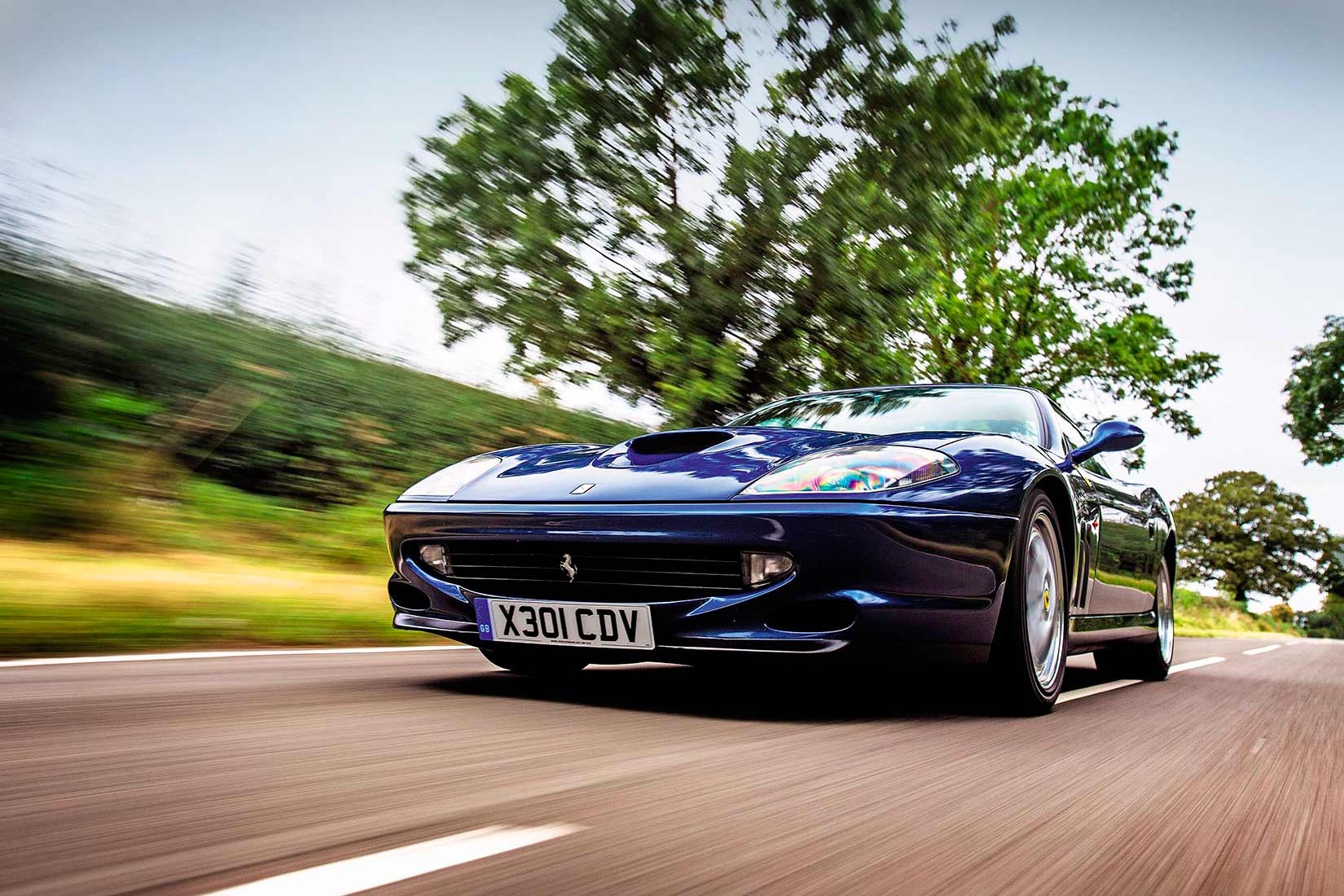
The complete Ferrari GT? Mighty 479bhp 550 Maranello tested. Awesome Ferrari 550M 199mph bargain Daytona. Ferrari 550 Maranello The Prancing Horse’s future past: a classic GT with real supercar pace. The supercar grows up. Alastair Clements puts away childish things to sample the 550 Maranello, a mighty GT that harks back to the glory days of the front-engined Ferrari V12 two-seater. Photography Malcolm Griffiths.
Let’s put aside the debate over when the modern ‘supercar’ was born for a moment, and try for the sake of argument to agree on a couple of points. First, a supercar needs to be mid-engined. And second, the first real supercar worthy of the name was the Lamborghini Miura in 1966 (the Ford GT40 wasn’t a true road car, after all). And where was Ferrari during all of this? Soldiering on with traditional front-engined flagships for another seven years until the success of the Dino persuaded Enzo to put the technology he’d been employing on the track for over a decade into practice in his most potent road cars.
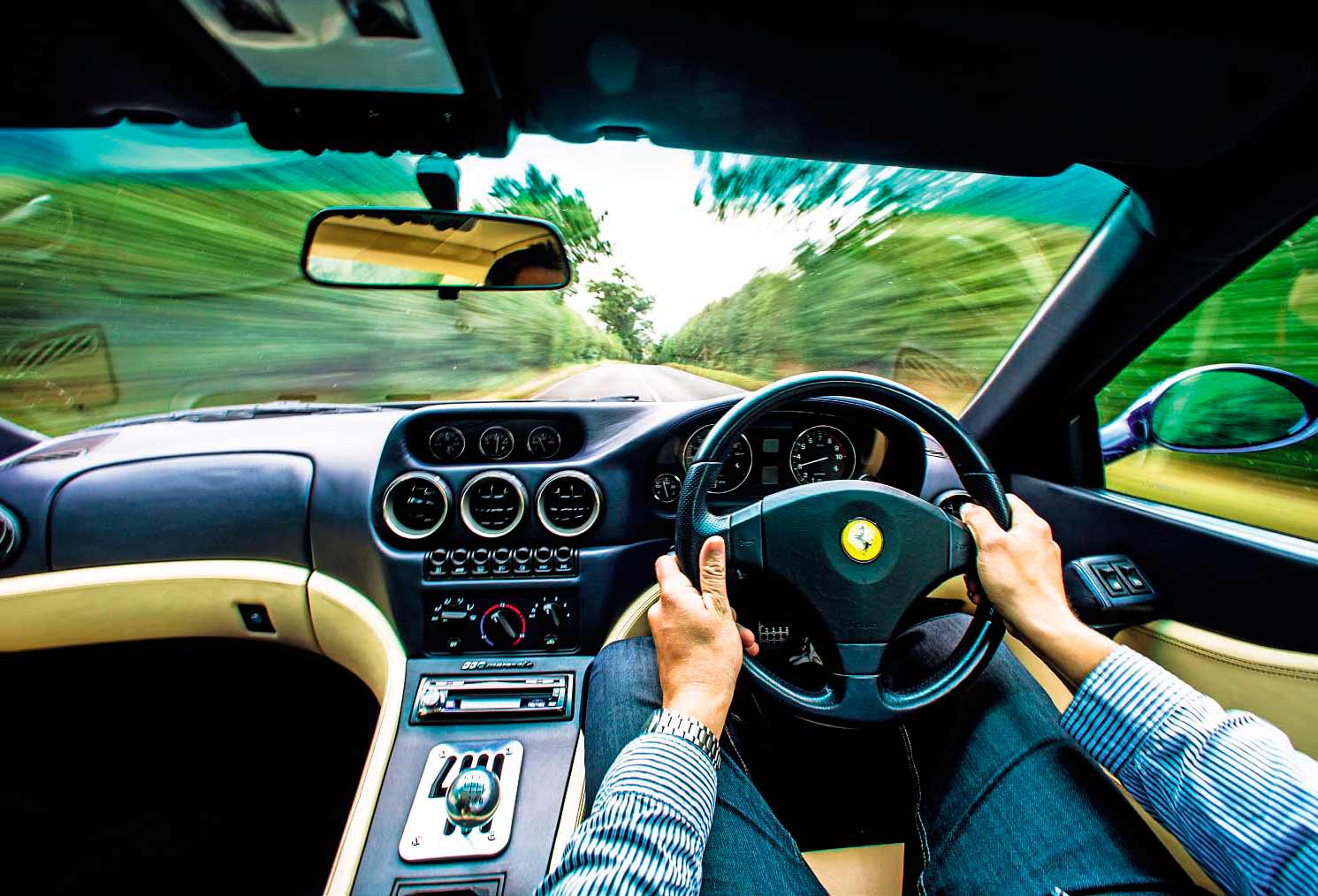
Ferrari 550 Maranello interior
When Ferrari did join the mid-engined pace race, of course, it jumped to the head of the queue and has remained there or thereabouts ever since. So why the 550 Maranello? Why, in 1996, turn your back on 23 years of development to create a car that in philosophy and fundamental technology was almost a carbon copy of the original Daytona?
Actually, that last point is pretty pertinent. In a world where the supercar wars were reaching their zenith, with a gaggle of wedgy machines that could all top 200mph, lap the Nürburgring at silly speeds and floor a schoolboy at 20 paces, something with the presence and hearty charisma of the Daytona was a welcome change. And there was another nod to the past in the name, Maranello, home and heart of Ferrari – albeit a place that sounds rather more exotic and glamorous than it looks in reality.
Glance at the spec sheet of the 550M and you could be looking through a brochure for the 365GTB/4, circa 1968: tubular steel chassis with aluminium panels; front-engined, rear-drive via a transaxle gearbox; double wishbones at each corner; and, of course, a dry-sump, all-alloy, quad-cam V12. Yet there was nothing backward about the way it went forwards: 3.5 secs faster around Ferrari’s Fiorano test track, in fact, than the mid-engined 512M it replaced. And it made complete sense in Ferrari’s expanding range: with the F50 taking care of the narrow hypercar niche, the brilliant F355 covering the everyman middie slot (well, every man with a spare £83,031) and the family-friendly 456GT, there was a gap for a 199mph super-GT that somehow blended the talents of them all. The 550M fitted it perfectly, completing a line-up which proved that Ferrari was mining a rich vein of road-car form arguably not seen since the 1960s.

Ferrari 550 Maranello 479bhp GT road test
Unlike the 456 and 355, however – and in spite of the ‘disegno pininfarina’ badges above those functional, GTO-style gills aft of the front wheels – the 550 is not a conventional beauty. There are hints of the F355 in the grille shape and of 456GT in the pertly styled rump, probably the 550’s most elegant view, but elsewhere this car is more about purpose than prettiness.
The aggressive face is fronted not by the popups that had been a Ferrari constant since the ’70s, but by three-part faired-in units with modern ‘projector’-style headlamps. And there are vents and scoops everywhere: ‘nostrils’ on either side of the front spoiler; a pronounced bonnet vent to increase intake pressure; even a duct let into the muscular nearside-rear haunch to cool a brake radiator. The attention to airflow continues beneath, with careful channelling and venturis to take the air past the rear-mounted transaxle and boost downforce.
Pull the neat little handle, swing open the frameless door and it’s clear that this car shares more than its (shortened) chassis and 5474cc V12 powerplant (albeit boosted by 42bhp) with the 456GT, because this is not the cabin of a stripped-out road-racer. The seats, though hip-hugging and brilliantly supportive, are comfortable and the overall ambience is one of superb quality, with immaculately trimmed leather covering everything from the centre console to the headlining. There are a few partsbin bits – notably the electric window switches and internal door latches – but they are easy to overlook, particularly once you come face to face with the intimidating central Jaeger dials: a rev counter redlined at 7600rpm and a 220mph speedo. They’re flanked by water temperature and oil pressure, with oil temperature, fuel and a clock in a separate trio above the central bank of toggle switches and air-con controls. It’s the kind of interior that makes you want to don your Persol shades and plot a course for Cannes.

Ferrari 550 Maranello 479bhp GT road test
But this is not Cannes, it’s Kenilworth. And unfortunately, just as I drop owner Mike Phillips home and fire up for a drive, the pervading drizzle thickens to a light storm. Not the ideal conditions in which to get to know a rear-wheel-drive 479bhp GT that weighs almost 1700kg and sits on vast, aquaplane-friendly 255/40 front and 295/35 rear Pirelli P-Zero Rossos. Initially, at least, it feels inordinately big as you nudge that long nose out into the traffic and remember that the vast 18in split-rim alloys (a factory option) have recently been refurbished.
But remarkably quickly, you realise that the 550M is not the animal that its statistics imply. Unlike its recalcitrant supercar rivals, the Ferrari is friendly: the clutch has a certain weight, but the heaviest control here is the throttle, and that somehow seems engineered-in to avoid the uninitiated using too much of it in one go. Hefty the car may be, but such is the V12’s potency that it still boasts a massive 287bhp per tonne – enough to take it from rest to 100mph in just 10.1 secs and on to a 199mph maximum. In Maranello circa 1996, only the F40 and F50 had ever been faster. Such is the incredible torque that you can leave it in fourth and it behaves like an auto, happy to pull from just above walking pace to speeds only legal on a deristricted autobahn with no fuss. Oddly, there’s curiously little noise either. There’s a potent rumble at idle from the non-standard Tubi exhausts, but on the move it’s more mechanical hum and muscular refinement than supercar blare. But this car was bought for its talent, not its ego – which is why most buyer chose to sidestep the Rossos and Giallos on the Ferrari colour chart in favour of more subtle Grigios and this beautiful shade of Blu Tour de France.
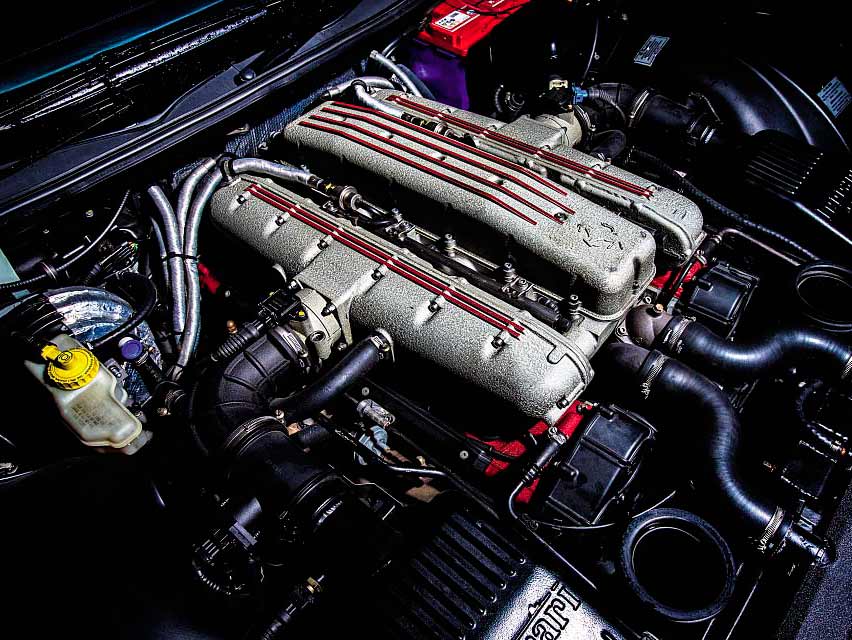
Ferrari 550 Maranello 479bhp V12 engine
With all of that power, all of that weight, and that archaic layout, you might expect the 550 to fall to pieces on a British B-road, but it doesn’t. Quite the opposite, in fact: for a big car, this GT is astoundingly nimble, thanks to a combination of super-sharp steering – 2.1 turns lock to lock – 50:50 weight distribution and a wider front track than rear that makes it dive into corners in a way that its equally bulky Aston Martin Vantage rival couldn’t approach. It also feels more of a piece than a Newport Pagnell product; the comfort can’t quite match that of a Jaguar XKR, but it rides bumps with firm authority thanks to clever adaptive dampers that also keep the body immaculately in check at speed.
There’s a fair amount of electrickery going on here, aside from those computer-controlled shock absorbers. The standard kit includes ‘ASR’ three-stage traction control, a character-changing ‘Sport’ button and speed-sensitive power steering, yet this car can still lay claim to being the last true analogue Ferrari, with no option of the shunting ‘automated manual’ F1 gearbox – favoured choice on the evolutionary 575 from 2002 – or fiddly ‘Manettino’ mapping controls on the steering wheel. Instead, there are three proper pedals and a classic aluminium balltopped gearknob. The click-clack change has a rewardingly positive action, but you have to watch your fingers in that polished gate because it’s a short lever. The steering isn’t full of feel in the traditional sense, but its weighting and accuracy are superb, giving the 550 incredible fluency cross-country for such a heavy car. Likewise, the Sport button enhances rather than spoils the experience, allowing a surprising amount of wheel slip – which means sideways fun without losing the electronic safety net.
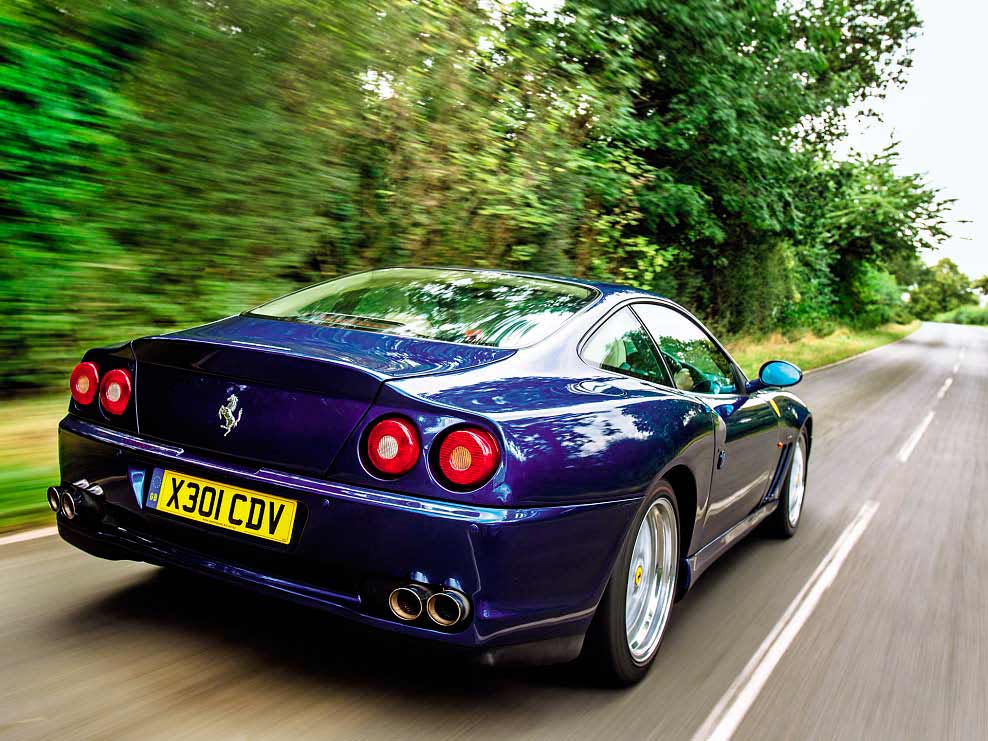
Ferrari 550 Maranello 479bhp GT road test
Such is the 550’s armoury, it’s not surprising that the Ferrari sold in healthy numbers for a car priced at in excess of £140,000, and its usability means that there are plenty of examples out there today with fairly significant mileages. Consequently, bearing in mind Cavallino collectors’ usual desire for low-milers, they can still be picked up for bargain prices. Ian Donaldson of supercar specialist Oakfields is convinced that 550Ms will never be any cheaper: “There is a distinct following for them, and it’s growing. The market began to wake up to the 550 around three years ago. The general opinion was that they were too cheap, with cars around for less than £35k – for one of Ferrari’s best all-round GTs.” Donaldson brought the first left-hooker to the UK in 1996: “It was the most comfortable and reassuring high-speed car I’d driven, and I’ve never had any major issues with them. It’s a complete Ferrari GT for very realistic money.”
Although cars with 50,000-plus miles are advertised for £40,000 or less, Donaldson reckons it’s worth spending a little more: “The ideal is a car with three to five owners, full Ferrari history in the original service book and less than 40,000 miles; at £45-55,000, they sell very quickly. Enthusiasts shouldn’t worry too much about mileage because they are well-engineered and the engine is so understressed, but collectors are looking for low-milers to put away. The centreline for a low-mileage car is around £60,000, with up to £10k leeway on either side, but if I found a 2000-mile car in Grigio I’d be asking £90,000. If you’re looking for a really good GT, I don’t think there’s a better car, and nobody is ever disappointed by it.”
Perhaps now is a pertinent moment to revive that original question: why the 550? A decade ago, for me, it was all about the middies. Diablo, XJ220, EB110, F40, F1 – the 550 didn’t even come into the picture. Yet I think I’ve matured, and now see the car with the eyes of the buyers Ferrari was targeting. It’s a car that will – easily – keep up with a Diablo SV in a straight line, not to mention giving it a scare on real-world roads, yet it’s comfortable, you can see out of it, put your luggage in it, and emerge from a 10-hour drive free from aches and pains. Suddenly it all starts to make sense.
Thanks to Oakfields: 01256 760256; www.oakfields.com
‘IT’S THE KIND OF CABIN THAT MAKES YOU WANTTO DON YOUR PERSOL SHADES AND PLOT A COURSE FOR CANNES’
‘THE SPEC READ LIKE THE DAYTONA, BUTTHERE WAS NOTHING BACKWARD IN THE WAY IT WENT FORWARDS’
TECHNICAL DATA FILE FERRARI 550 MARANELLO
Sold/number built 1996-2001/3083
Construction tubular steel chassis, aluminium panels
Engine all-alloy, dohc-per-bank 5474cc 65º V12, Bosch Motronic fuel injection
Max power 479bhp @ 7000rpm / DIN
Max torque 419lb ft @ 5000rpm / DIN
Transmission six-speed manual transaxle, driving rear wheels
Suspension independent, by double wishbones, coil springs, adaptive telescopic dampers and anti-roll bar
Steering rack and pinion, with speed-variable power assistance
Brakes 13in (330mm) front, 12 ¼ in (310mm) rear ventilated and cross-drilled discs, with servo and anti-lock
Length 14ft 11in (4550mm)
Width 7ft 1 ¾ in (2180mm)
Height 4ft 2 ¼ in (1277mm)
Wheelbase 8ft 2 ½ in (2500mm)
Weight 3732lb (1693kg)
0-60mph 4.6 secs
Top speed 199mph
Mpg 12.3
Price new £143,685
Price now (2017) £35,000-175,000
{module Ferrari 550 Maranello}
THE OWNER Mike Phillips
It’s four and a half years since this charteredaccountant bought his first Ferrari, but it was only after he retired 12 months ago that the 550 began to get regular use, including a run to the Le Mans Classic.
“Sometimes I just stick a date in the diary to go off and drive,” says Phillips, for whom the V12 was a big step up from his previous fun car, a Mazda MX-5: “I’m passionate about Ferrari, and knew I would always have that yearning. They seemed so reasonable that I thought I’d better do it.” After a six-month search, he dropped in at Verdi for a chat, and drove away £50k poorer in the 550: “The Ferraris I loved were the classic front-engined GTs that ran at Le Mans; I had no interest in a mid-engined car. I felt intimidated by it at first, but then realised I could have spent more on a new BMW and I relaxed a bit. It’s very usable and has had no mechanical problems so far.” Phillips budgets c£2000 per year for servicing: “But it does drink fuel. I struggle to get 14mpg. I am tempted to do a track day… but I’d rather use someone else’s car!”
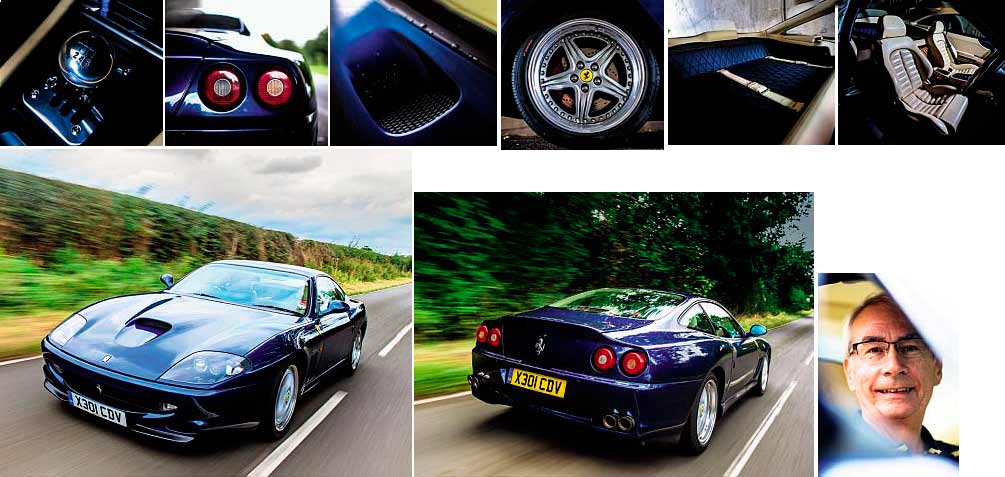
The Owner Mike Phillips. Clockwise, from above: rear three-quarter is the 550’s most stylish view; leather-wrapped cabin is beautifully finished; diamond-stitched luggage bay; optional split-rims. From far left: superb seats cosset and support; alloy gearlever; signature round lamps; duct cools brake fluid. Below: big car has stunning balance; 5474cc V12 shared with 456GT.





